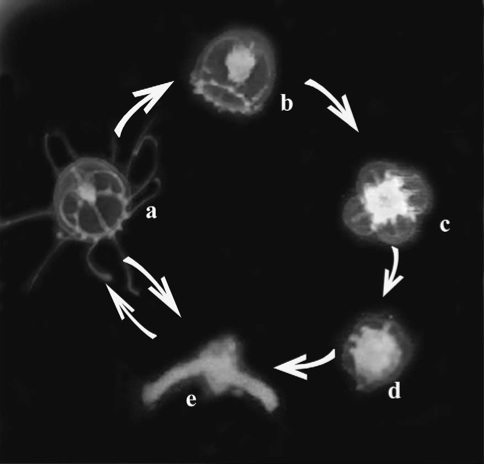The Immortal Jellyfish
Biology 342 Fall 2011
Eric Van Baak
Ontogeny of the Reverse Life Cycle: Ontogeny, and Ontogeny, and Ontogeny...
As the image to the right, taken from E. C. Carla et al.'s comprehensive study of T. nutricula morphology, shows, T. nutricula's life cycle comes back around on itself. An individual begins its life cycle  by transforming from a planula, or larva (not shown), into the sexually immature polyp form (e on the image).
These polyps are sessile,resting on the sea floor in hydroid colonies.The medusa form (a) buds off from these colonies and is sexually mature within a month, less in warmer water. In this form, the jellyfish may release or fertilize eggs, depending on sex; these eggs will go through a larval stage and eventually yield more polyp forms. Most jellyfish do not survive particularly long in medusa form; the form shown at (b) on the image is considered "unhealthy", and would likely soon die.
by transforming from a planula, or larva (not shown), into the sexually immature polyp form (e on the image).
These polyps are sessile,resting on the sea floor in hydroid colonies.The medusa form (a) buds off from these colonies and is sexually mature within a month, less in warmer water. In this form, the jellyfish may release or fertilize eggs, depending on sex; these eggs will go through a larval stage and eventually yield more polyp forms. Most jellyfish do not survive particularly long in medusa form; the form shown at (b) on the image is considered "unhealthy", and would likely soon die.
However, under environmental stress induced by changes in temperature or salinity, or damage to its body, T. nutricula possesses the ability to reabsorb the medusa form into a four-leaf clover shape (c), dramatically increasing cell degeneration and causing much of its body to literally break apart. This shape then seals itself up into a still more compact cystic form (d) - essentially, a durable ball in which apoptosis occurs at a much higher rate than normal. In this case, the purpose of this apoptotic cell death is to destroy those parts of the body that were dominant in the adult Turritopsis, while retaining the structures necessary to form the polyp - interestingly, the most prominent of these retained structures are the gonads.
Genetic regulation of this process remains poorly understood. The existence of some signal pathway that links external trauma to the medusa with the beginning of the reversion process has been assumed. The identification of this signal pathway, and how it interacts with the genetic mechanism required to undertake such a considerable process as the destruction of much of the medusa's body, would be a useful point of inquiry for future research.